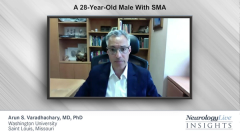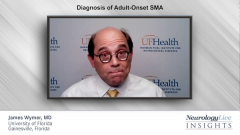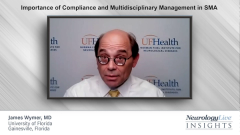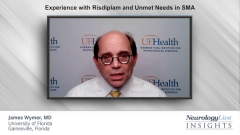
The Safety and Efficacy of Nusinersen for SMA
A specialist in the care of patients with spinal muscular atrophy reviews the CHERISH trial of nusinersen and examines the drug’s safety and efficacy profiles.
Episodes in this series

Arun S. Varadhachary, MD, PhD: Starting a medication like Nusinersen is a very personal decision, because patients have different goals and expectations for treatment. However, starting on a medication such as Nusinersen implies that patients are going to be fully engaged in their care plans and want to be active participants with their multidisciplinary team to optimize function. We tend to discuss the motivations of patients to make sure that they are able to fully engage with a plan that we can put together for them.
When we specifically discuss starting therapy with Nusinersen, we explain that the first couple of months are a lot of work because of the loading dose schedule for this medication. Within the first 2 months, a total of 4 injections are given in fairly rapid succession. After the loading doses are completed, patients enter a maintenance phase, in which they undergo repeated treatment every 4 months. At that point, most patients become used to a pattern of seeing their doctor every couple of months. They actually begin to look forward to those visits to check in, report their symptoms, and share what they believe are the benefits of undergoing treatment.
The safety profile of Nusinersen has been studied across a large range of patients. Most of the adverse effects that patients experience relate to its administration via lumbar puncture, which can sometimes lead to headaches, backache, etc. In terms of the actual safety profile of the medication itself, the drug is very well tolerated. However, as with all medications, there are some adverse events, and data from the initial studies demonstrated that patients should be monitored for kidney function and coagulation problems that can result from medications in the same class as Nusinersen.
Some efficacy data regarding [Nusinersen] come from a series of clinical trials. The pivotal clinical trial is relevant for older-onset SMA [spinal muscular atrophy] patients—specifically, patients who would fall within the type 2 or type 3 category—observed in the CHERISH study. This was a study with 126 patients with type 2 or type 3 SMA who were 2 to 9 years of age. After 15 months of treatment, primary outcome school performance was measured using the Hammersmith Functional Motor Scale–Expanded (HFMSE). Patients who were receiving Nusinersen showed an improvement of 3.9 points on their [HFSME] score over that 15-month time period when compared with the placebo control group. The improvement was considered both statistically and clinically significant. Some other outcomes of that CHERISH study included performance in the revised upper limb module, which also showed improvement among individuals on treatment as compared with those who were not. For the individuals able to walk, the CHERISH study also demonstrated an improvement in the 6-minute walk test performance.
That said, the CHERISH study did look at a quite young population. Subsequently, we were waiting for was some data that was more specific for older patients who would fall within the adult category of SMA patients. We had two observational studies following large cohorts of patients published in 2020, one in the spring, and the other later in the fall. One group studied patients in Germany, and another studied a group in Italy. Adult patients were followed for 14 months and assessed using rating scale scores also used in the pivotal studies, namely the Hammersmith score, the upper limb module test, and the 6-minute walk test. The adults showed improvement or stabilization in their Hammersmith scores over this time period. In aggregate, patients who were receiving Nusinersen experienced stabilized or improved motor function. This is encouraging news for those of us who care for adult patients, because we want data that we can cite to let them know that this medication is, in fact, doing what we think it's doing, and that the benefits that they see are comparable to the benefits observed in the younger population of patients.
Transcript Edited for Clarity
Newsletter
Keep your finger on the pulse of neurology—subscribe to NeurologyLive for expert interviews, new data, and breakthrough treatment updates.






































